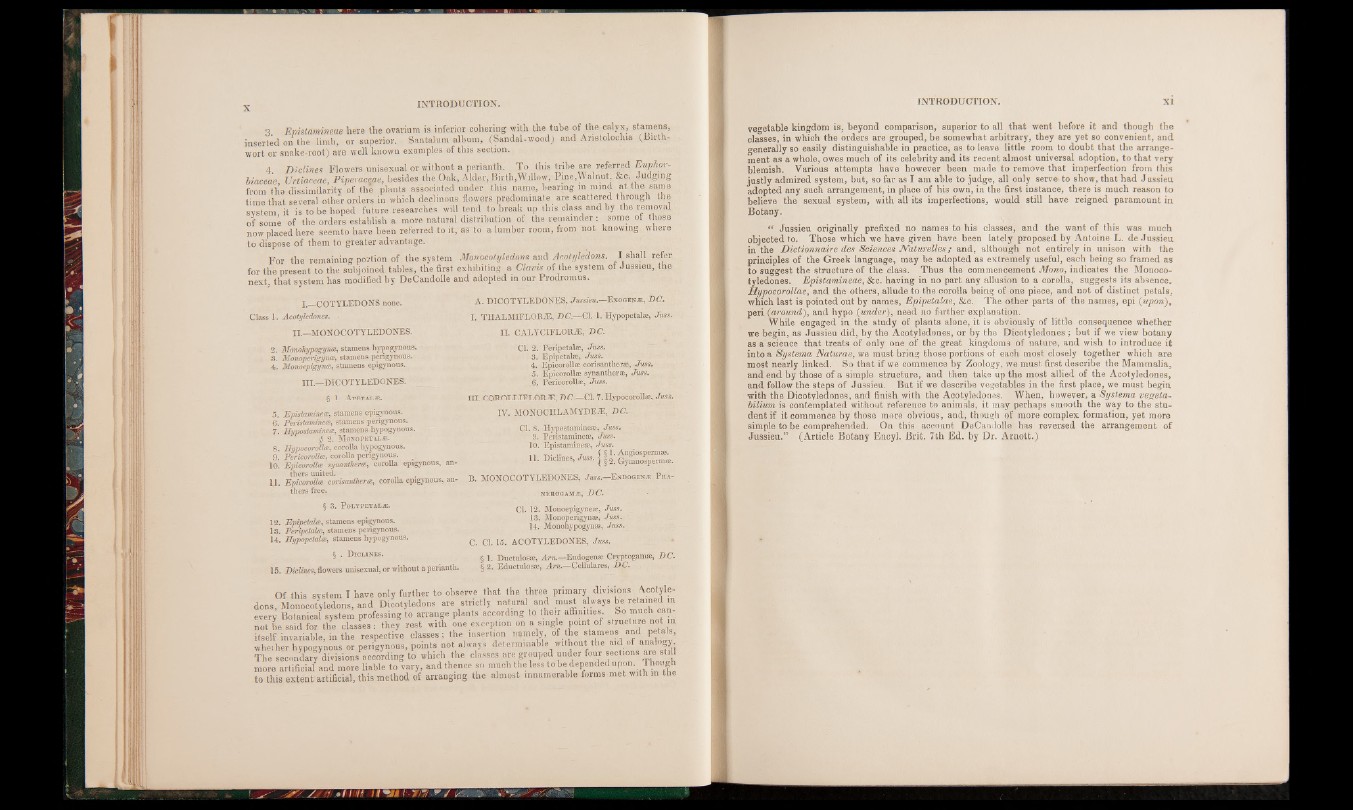
3 Evistamineae here the ovarium is inferior cohering with the tube of the calyx, stamens,
inserted on the limb, or superior. Santalum album, (Sandal-wood) and Anstolochia (birth-
wort or snake-root) are well known examples of this section.
4 Declines Flowers unisexual or without a perianth. To this tribe are referred Euphor-
biaceae Urtiaceae, Piperaceae, besides the Oak, Alder, Birth,Willow, Pine,Walnut, &c. Judging
from the dissimilarity of the plants associated under this name, bearing m mind at the same
time that several other orders in which declinous flowers predominate are scattered through the
svstem it is to be hoped future researches will tend to break up this class and by the removal
of some of the orders establish a more natural distribution of the remainder : some ot those
now placed here seemto have been referred to it, as to a lumber room, from not knowing, where
to dispose of them to greater advantage.
For the remaining portion of the system Monocotyledons and /Icotyledons. I shall refer
for the present to the subjoined tables, the first exhibiting a Clavit of the system ot Jussieu, the
next that system has modified by DeCandolle and adopted in our Prodromus.
I.—COTYLEDONS none.
Claes 1. Acotyledones. ■
II.—MONOCOTYLEDONES.
2. Monohypogynoe, stamens hypogynous.
3. Monoperigynoe, stamens perigynous.
4. Monoepigynæ, stamens epigynous.
HI.—DICOTYLEDONES.
§ 1. APETAX.Æ.
5. Epistamineoe, stamens epigynous.
6. Peristamineoe, stamens perigynous.
7. Hypostamineoe, stamens hypogynous.
ÿ 2. MoXOPETAIiÆ.
8. Hypocorolloe, corolla hypogynous.
9. Pericorolloe, corolla perigynous.
10. Epicorolloe synantheroe, corolla epigynous, anthers
united.
11. Epicorolloe corisantheroe, corolla epigynous, anthers
free.
§ 3. POLYPETALÆ.
12. Epipetaloe, stamens epigynous.
13. Peripetaloe, stamens perigynous.
14. Hypopetaloe, stamens hypogynous.
§ . Diculnes.
15. Diclines, flowers unisexual, or without a perianth.
A. DICOTYLEDONES, Jussieu.—ExogenÆ, D C .
I. THALMIFLORÆ, D C — Cl. 1. Hypopetalae, Juss.
n. CALYCIFLORÆ, DC.
Cl. 2. Peripetalæj Juss.
3. Epipetalae, Juss.
4. Epicorollæ corisantheroe, - Juss.
.5. Epicorollæ synantheræ, Juss.
Pericorollæ, Juss.
III. CQROLLIFLORÆ,D C —Cl. 7 .Hypocorollæ, Juss.
IV. MONOCHLAMYDEÆ, DC.
Cl, 8. Hypostamineæ, Juss.
9. Peristamineæ, Juss.
10. Epistamineoe, Juss.
. . .. T f § 1. Angiospermæ.
11. Diclines, ,Jy&s, 1 1 2. GySm0Speniiæ.
B. MONOCOTYLEDONES, Juss.- -Ksmwtx* Pua-
NEROGAMÆ, DC.
Cl. 12. Monoepigyneæ, Juss. _
13. Monôperigynæ, Juss.
14. Monohypogynoe, Juss.
C. Cl. 15. ACOTYLEDONES, Juss.
§ 1. Ductulosoe, A m .—Endogenoe Cryptogamoe, DC.
§ 2. Eductulosoe, A m .— Cellulares, DG.
Of this system I have only further to observe that the three primary divisions Acotyle-
dons, Monocotyledons, and Dicotyledons are strictly natural and must always he
every Botanical system professing to arrange plants according to their affinities. So much cannot
be said for the classes : they rest with one exception on a single point of structure not in
itself invariable, in the respective classes; the insertion namely, of he stamensi and petals,
whether hypogynous or perigynous, points not always determinable without the aid of analogy
The secondary divisions according to which the classes are grouped under four sections are still
more artificial and more liable to vary, and thence so much the less to be depended upon. Though
to this extent artificial, this method of arranging the almost innumerable forms met within the
vegetable kingdom is, beyond comparison, superior to all that went before it and though the
classes, in which the orders are grouped, be somewhat arbitrary, they are yet so convenient, and
generally so easily distinguishable in practice, as to leave little room to doubt that the arrangement
as a whole, owes much of its celebrity and its recent almost universal adoption, to that very
blemish. Various attempts have however been made to remove that imperfection from this
justly admired system, but, so far as I am able to judge, all only serve to show, that had Jussieu
adopted any such arrangement, in place of his own, in the first instance, there is much reason to
believe the sexual system, with all its imperfections, would still have reigned paramount in
Botany.
<e Jussieu originally prefixed no names to his classes, and the want of this was much
objected to. Those which we have given have been lately proposed by Antoine L. de Jussieu
in the Dictionnaire des Sciences JYaturelles ; and, although not entirely in unison with the
principles of the Greek language, may be adopted as extremely useful, each being so framed as
to suggest the structure of the class. Thus the commencement Mono, indicates the Monoco-
tyledones. Epistamineae, &c. having in no part any allusion to a corolla, suggests its absence.
Hypocorollae, and the others, allude to the corolla being of one piece, and not of distinct petals,
which last is pointed out by names, Epipetalae, &c. The other parts of the names, epi (upon),
peri (around), and hypo (under), need no farther explanation.
While engaged in the study of plants alone, it is obviously of little consequence whether
we begin, as Jussieu did, by the Acotyledones, or by the Dicotyledones; but if we view botany
as a science that treats of only one of the great kingdoms of nature, and wish to introduce it
into a Systema Naturae, we must bring those portions of each most closely together which are
most nearly linked. So that if we commence by Zoology, we must first describe the Mammalia,
and end by those of a simple structure, and then take up the most allied of the Acotyledones,
and follow the steps of Jussieu. But if we describe vegetables in the first place, we must begin
with the Dicotyledones, and finish with the Acotyledones. When, however, a Systema vegeta-
bilium is contemplated without reference to animals, it may perhaps smooth the way to the student
if it commence by those more obvious, and, though of more complex formation, yet more
simple to be comprehended. On this account DeCandolle has reversed the arrangement of
Jussieu.” (Article Botany Encyl. Brit. 7th Ed. by Dr. Arnott.)